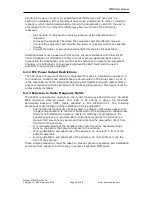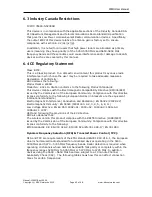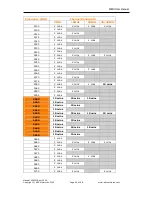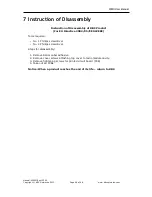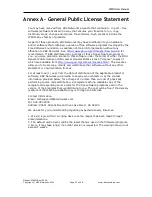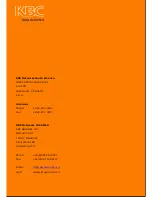
WESII User Manual
Manual-WESII-Rev1205A
Copyright © KBC Networks 2012
Page 42 of 48
www.kbcnetworks.com
situations. However, there is no guarantee that interference will not occur in a
particular installation. If this equipment does cause interference to radio or television
reception, which can be determined by turning the equipment on and off, the user is
encouraged to try to correct the interference but on or more of the following
measures:
Re-orientate or relocate the receiving antenna of the affected radio or
television.
Increase the separation between the equipment and the affected receiver.
Connect the equipment and the affected receiver to power outlets on separate
circuits.
Consult the dealer or an experienced radio/TV technician for assistance.
Shielded cables must be used with this unit to ensure compliance with Class B FCC
limits. Changes or modifications to this unit not expressly approved by the party
responsible for compliance could void the user’s authority to operate the equipment.
Changes or modifications not expressly approved by KBC could void the user’s
authority to operate the equipment.
6.2.2
FCC Power Output Restrictions
The FCC does not require licensing to implement this device. License-free operation in
the industrial, scientific and medical band is documented in FCC Rules Part 15.247. It
is the responsibility of the individuals designing and implementing the radio system to
ensure compliance with any pertinent FCC Rules and Regulations. This device must be
professionally installed.
6.2.3
Exposure to Radio Frequency Fields
The WESII is designed to operate on the 5 GHz frequency band with up to 50 Watts
EIRP maximum transmit power. This level of RF energy is above the Maximum
Permissible Exposure (MPE) levels specified in FCC OET65:97-01. The following
precautions must be taken during installation of this equipment:
The installed antenna must not be located in a manner that allows exposure of
the general population to the direct beam path of the antenna at a distance less
than 20cm. Installation on towers, masts, or rooftops not accessible to the
general population is recommended or alternatively mount the antenna in a
manner that prevents any personnel from entering the area within 20cm from
the front of the antenna.
It is recommended that the installer place radio frequency hazard warnings
signs on the barrier that prevents access to the antenna.
During installation and alignment of the antenna, do not stand in front of the
antenna assembly.
During installation and alignment of the antenna, do not handle or touch the
front of the antenna.
These simple precautions must be taken to prevent general population and installation
personnel from exposure to RF energy in excess of specified MPE levels.















